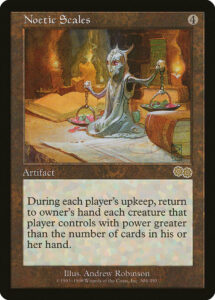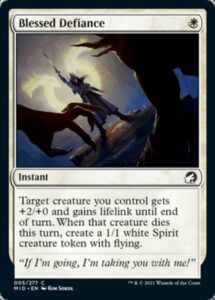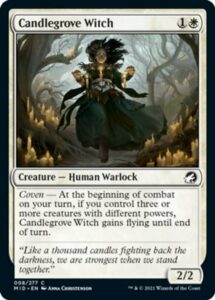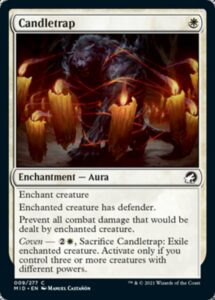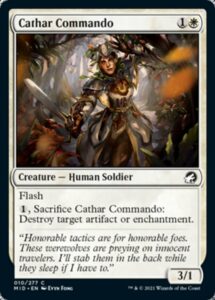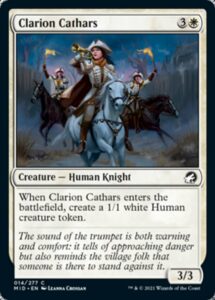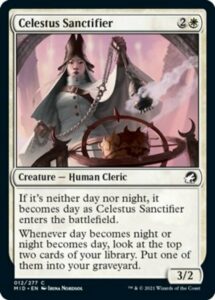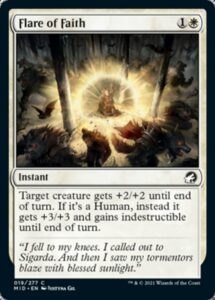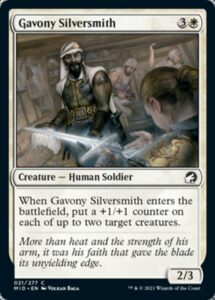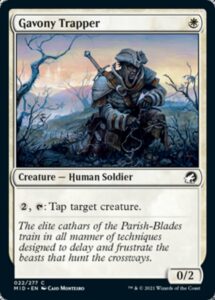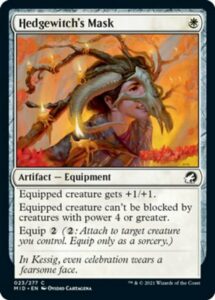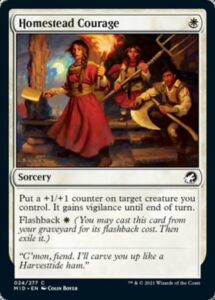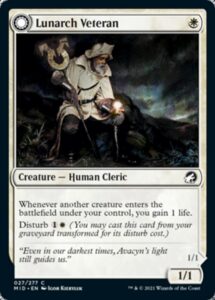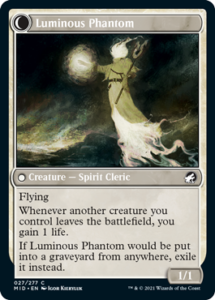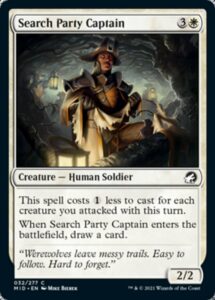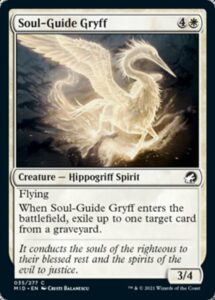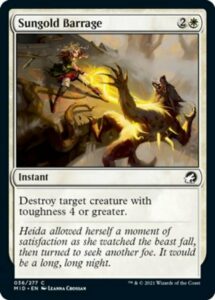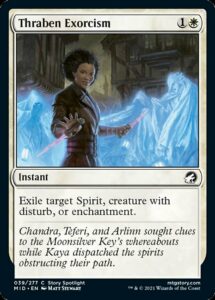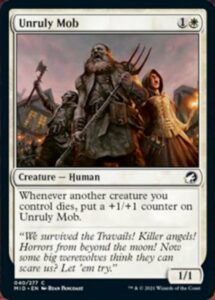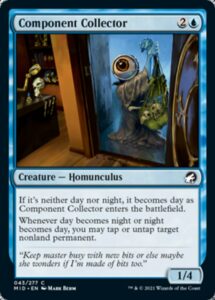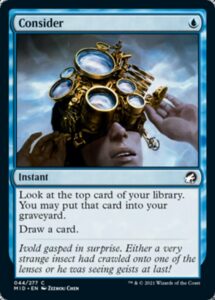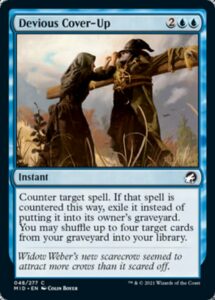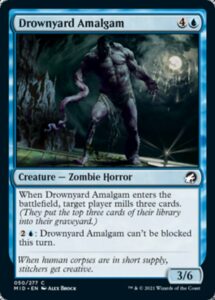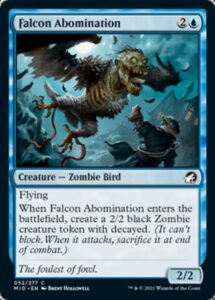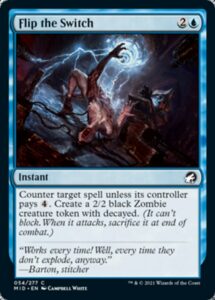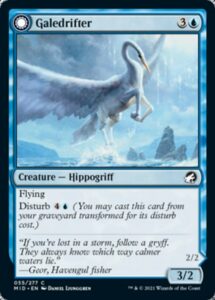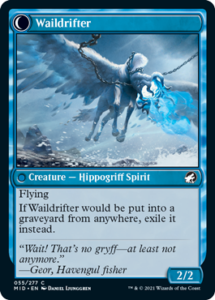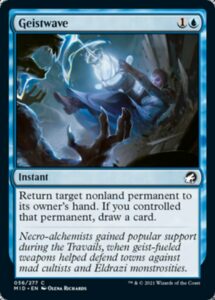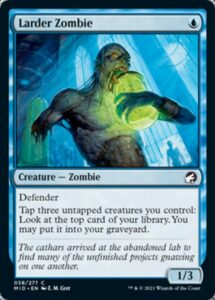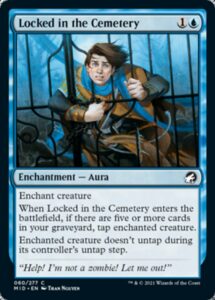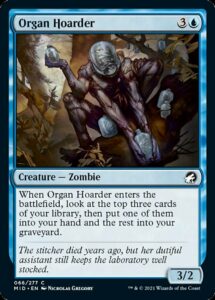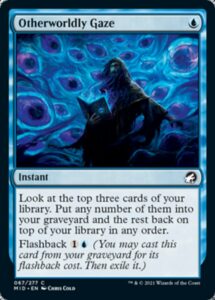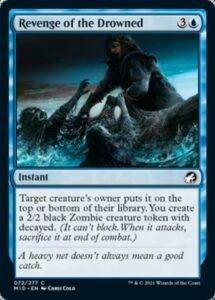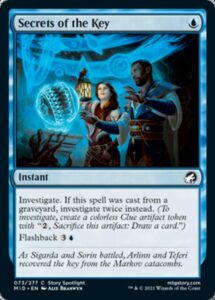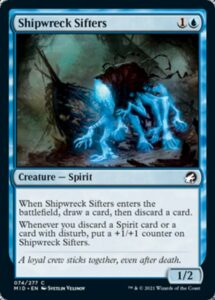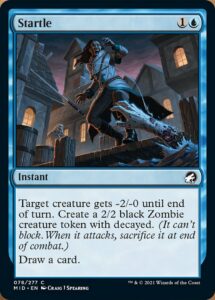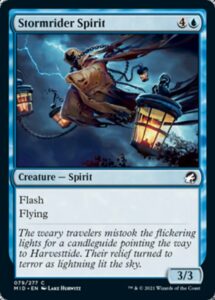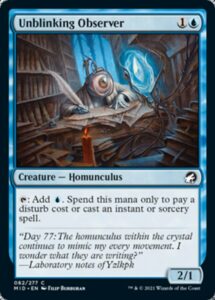Welcome back, everyone! We return to the classic version of one of my favorite planes, Innistrad! Drafts begin in just two days thanks to Magic Arena, so we’ve got very little time to assess the set and prepare.
Last week, we reviewed Innistrad: Midnight Hunt’s structure. It’s got a wealth of mechanics, complexity, and innovation, though there’s a risk of too much stuff. All of that affects how Limited will play. Be mindful of how Decayed synergizes with sacrifice outlets and tapping creatures like Siege Zombie, how cheap spells like Consider can help switch night to day, and how the mechanics are distributed between colors.
This week, we’re going to quickly review every common to help folks get a jump on the competition. I am assessing these cards based on past experiences and guesses about how Midnight Hunt’s peculiarities will recontextualize cards.
The Scale
I use a different kind of scale than folks might be used to. I want to employ the full spectrum of letter grades and am only considering commons, so powerful higher rarity cards would go off the scale. Elsewhere, an A or 5.0 refers to unbeatable (often mythic rare) bombs. Here, it refers to set’s top commons. I’ll also avoid using pluses and minuses to keep from splitting hairs (where possible).
A: One of the best commons in the set. These are first-pickable (but often pale in comparison to strong higher rarity cards).
B: A high quality common. It should almost always make your deck (if it’s in your colors) and sends a strong signal that this color is open. This can also include powerful, archetype-specific cards that don’t go into every deck of this color.
C: A fine common. This includes most creatures with decent stats, serviceable removal spells, and strong combat tricks.
D: A serviceable common. This category tends to include most combat tricks (they compete for space with creatures and removal, so I rate them lower), as well as cards that can be strong out of the sideboard.
F: You’d rather these cards not go into your deck. This includes low-power cards and cards that in very specific archetypes might have a role to play. Maybe.
White Commons
This is a twist on cards like Make Your Mark and Otherworldly Outburst. The combat trick is a bit better and the creature is much worse. These tend to underperform. It’s cute with Decayed zombies and Disturb creatures, but building your own 1.5-for 1 with a high possibility of failure isn’t a strong starting point.
Grade: F
It remains to be seen how easy it is to achieve Coven and how aggressive the format is. Moorland Drifter could always fly when active, while Candlegrove Witch can only fly while attacking. If Coven is sufficiently rewarding or GW Humans/Aggro functional, Candlegrove Witch could be a critical two drop. Or it could be filler.
Grade: C (with the prospect of it going up or down a full grade)
Guard Duty cards tend to be weaker than they look. White aggro decks don’t want removal that creatures a speedbump, while slower decks give the opponent time to regain value from the creature. This is serviceable removal which you’ll happily play, but people will confuse for a much stronger spell by virtue of its mana cost and mountain of text.
Grade: C
Devilthorn Foxes are rarely good. They trade with everything, die to every removal spell, and are frequently punished by incidental damage effects and tokens. But Cathar Commando is a very flexible card. It can function as an artifact, enchantment, or cheap creature removal spell. It’s a cheap creatures with 3 power for Coven decks. It might even play well in slower decks because of its modality. A lot less needs to go right for Cathar Commando to be good than for Candlegrove Witch.
Grade: B
Card advantage and two bodies for Coven could make Clarion Cathars a fine inclusion in GW Coven and WB sacrifice. In practice, Hill Giants with minor upside usually aren’t playable anymore.
Grade: D
We’ve almost never seen white get repeatable card selection or graveyard filling at common. This does both. That’s a neat innovation, but it’s not clear how easily it’ll be to get value off of Celestus Sanctifier. It won’t often be night on turn 3 and taking turn 4 or 5 off to switch time zones is probably a great way to lose the game. Plus, it’s a three mana 3/2, which tends to trade down on mana.
Grade: D
On a nonhuman, this is a very poor combat trick. In a deck full of humans, this is well above rate. There may be some decks that value this very highly, but the floor is low.
Grade: D
Support 2 is a powerful, swingy effect. Even the mighty Basri’s Acolyte wasn’t that impressive if it only had one target. But Gavony Silversmith can target itself, making the floor substantially higher. With only a little bit of work, Gavony Silversmith is four power, some with haste – not bad for a set with Coven. Though it is pretty weird having this and Clarion Cathars in the same set.
Grade: B
Akroan Jailers generally underperform. Two mana is a hefty cost until you hit the top end of your curve. A 0/2 is generally slightly weaker than a 1/1. Still, tappers are powerful effects, especially in aggressive decks. And Gavony Trapper could turn its zero power into a strength alongside Coven. In other formats, this would be a D in my book, but I’ve got high (well, moderate) hopes for this one.
Grade: C
I like this bonus, since it can make your opponent’s life awkward by suiting up a 3+ toughness creature. It also makes Coven a bit easier to achieve by diversifying same-power creatures. That said, it’s still an equipment that provides minor bonuses in a format where equipment isn’t rewarded.
Grade: F
Travel Preparations was one of the strongest commons in original Innistrad. It generated a lot of power (that effectively had haste) our of nowhere and could spread its bonus among 3+ creatures. Homestead Courage is better on mana but worse on every other metric. It could be a component of another heavy-white aggro deck that preys on greedy decks (as was the case in Kaldheim and Strixhaven), but the risk here is so high and the reward so narrow.
Grade: F
Too much needs to go right for Lunarch Veteran. For aggressive decks, this is no Doomed Traveler. Lifegain isn’t an archetype and it’s hard to gain much life off of this. It could serve as a role-player across multiple archetypes by virtue of having many synergies, but this is another white card with a very low floor.
Grade: F
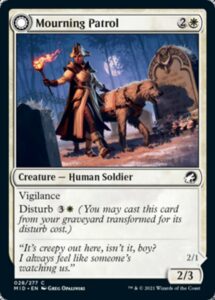
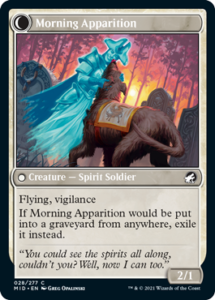
What a wonderful little story! As a card, this seems fair but unexciting. A 2/3 Vigilance is an acceptable creature (that gets quite good with a +1/+1 counter) and it’s not too hard to get a card’s worth of value out of an extra 2/1. It feels like one of white’s better creatures, not because it’s especially strong in and of itself, but because it can go in a variety of decks and generate card and board advantage in all of them.
Grade: B
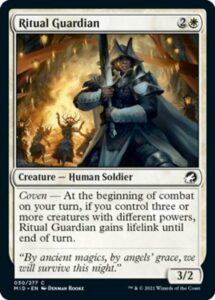
I’m suspicious of white having two common 3/2s for 3. Maybe Celestus Sanctifier and Ritual Guardian are both playable, but both are an unimpressive set of stats paired with an ability that requires time to function. Lifelink is a very powerful ability, but conditional Lifelink that only works on offense isn’t as impressive.
Grade: D
Over the course of a year, White has gone from symmetrical drawing creatures like Farsight Adept to cantripping creatures like Priest of Ancient Lore. Now it gets serious cost reduction, too. White looks fairly aggressive at common, so it shouldn’t be too challenging to convert this from an underwhelming Nimble Innovator into an excellent card.
This is my pick for white’s best common. That’s partly a reflection of its removal not impressing me, but also how creature-focused White is and just how powerful card advantage stapled to board presence can be.
Grade: B
It’s been two years, and white is getting 3/4 Flyings for five with minor upside. These are usually decent and rarely better than that. You can’t play that many 5+ mana cards, especially with how powerful 2-3 mana creatures have become.
Grade: C
In most formats, Pillar of Light and Smite the Monstrous are fringe-playable, usually better out of the sideboard than in the main deck. They tends to trade up in mana, but can have so few targets that they rot in your hand instead. Because of Transform, this has a fair number of targets against black, red, and green decks, but I’d be reticent to run more than one at the beginning of the format.
Grade: D
Urgent Exorcism with upside is still a sideboard card. This may be better than its forebear against WU decks (since there are rewards for playing lots of spirits and a higher density of playable spirits), but it’s still most likely a sideboard card.
Grade: F
Unruly Mob is back. This style of card can be so dangerous in attrition matches or when you’re regularly sacrificing creatures for value. Outside of a Decayed-heavy deck, this probably doesn’t have a high enough ceiling. And that floor here is terrible.
Grade: D
Blue Commons
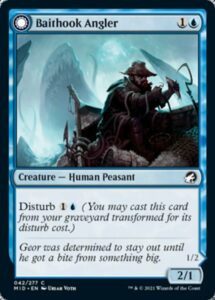
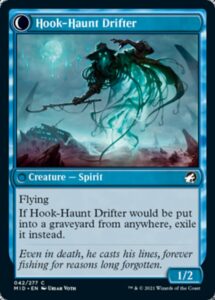
Two mana 2/1s generally need extra help to be playable. Dying into a 1/2 that you still need to cast isn’t reel-y what you want to be doing. This has a lot of synergies that might pull it up the rankings, but absent them, you should toss it back.
Grade: D
Horned Turtles are worse than they used to be. They eat fewer creatures while blocking and often can’t stop opposing three mana creatures. The bonus here is cute—you can tap down an opposing creature sometimes, but it remains to be seen how feasible it’ll be to transform night back into day more than once or twice. This could be a potent component for a day/night switching deck where you amass 3+ triggers each time, but we can do better than a Horned Turtle that might accidentally let your opponents’ werewolves enter on their Nightbound side.
Grade: D
Cantrips are often overvalued in Limited because of their power in Constructed. In Constructed, finding lands and sifting through your powerful cards to find the right tool is desirable. Limited is most often determined by a density of power rather than finding your few best cards, and cantrips take up a slot that could contain a creature.
All that said, the bonus here is nice. Binning a flashback or Disturb card can effectively turn this into a 1.5 for 1, and it makes turning night back into day facile. So I’ll overvalue this, even if it’s probably on par with Opt (which isn’t saying much).
Grade: C
This is a Guilds of Ravnica reprint I wasn’t expecting to see again anytime soon. It was a potent (and frustrating) element of the Flash-heavy Dimir control deck, where you could Surveil through your entire deck, recur your best cards, and never deck if you had two of these. Countermagic normally isn’t very good in Limited, yet this mana-inefficient counterspell did solid work in 2018.
Those factors don’t seem to apply here. Not only is there less for an instant-speed deck, but holding up four mana is great way to flip your opponents’ werewolves for them.
Grade: F
Ashiok’s Skulker was a begrudging playable in a very high power level draft format. Drownyard Amalgam is stronger in every way. It’s still a five mana play, but this blanks almost every ground creature and can attack well even without a mana payment.
Grade: C
Wind Drake is the card I’ve most discussed throughout the years. They’ve gotten weaker over the years and need extra bonuses to compete. Even the mighty-looking Frost Trickster was merely fine in Strixhaven.
Making a Decayed zombie token looks to cost about 0.25 mana (about the same as Venturing or gaining Reach, so a very minor effect), but the real question is whether you’ll be able to profitably use the token at all. It’s usually hard for blue decks to apply enough pressure so that a 2/2 that dies when it attacks isn’t blanked by a blocker. Then again, curving this into Vivisection will feel amazing. If it’s too difficult to get value out of the zombie token, I think this Wind Drake will be a C that too many people see as a top tier common.
Grade: B
It’s odd seeing this an Devious Cover-Up together. This is a slightly stronger spell with the exact same weaknesses and different bonus.
Grade: F
Snapping Drake has aged about as well as Wind Drake. It’s big enough to be a threat, but it’s harder to keep the ground clear enough so that it applies meaningful pressure. With Galedrifter, you get both in one card. The combination of card advantage and synergy gives this a decently high ceiling with a floor of Snapping Drake.
Grade: B
Disperse vacillates between weakness and strength. Where it lands depends on factors such as blue’s ability to apply pressure, whether there are disruptable mechanics like Heroic or Monstrosity, and the quality of combat tricks and cost of removal. In Midnight Hunt, blue seems to err more on the side of tempo Skies (which generally likes bounce) and slower decks (which generally don’t).
Geistwave‘s innovation is taking Unsummon‘s secondary mode (bouncing your own creature) and turning it into Call to Heel. This will feel sweet when you’re recurring a Disturb creature or Dismissing a removal spell, but you still need to recast your creature. I think folks will get that wrong when evaluating this.
If the cards line up, this could be blue’s best spell, disrupting Covens and werewolves while making it easy to turn night into day. Or it could just be a fine playable.
Grade: C
If Spider Spawning were in this set, Larder Zombie could be a real component of it. But this doesn’t work with Seize the Storm and can’t deck your opponent, so I’m skeptical that this hangry zombie will work wonders with its Decayed friends.
Grade: F
Claustrophobia effects have been getting stronger due to enchantment-based removal being outpaced by better creatures and all the ways to wreck them. The fact that this can’t disrupt a Coven and requires (almost) Threshold to function proactively makes me feel like this is the kind of spell you want one copy of and no more.
Grade: C
Turns out, if you hoard enough organs, you get Strategic Planning. I don’t love how this trades with a two drop, but it’s nevertheless a two-for-one with not-awful stats and more likely to trade with a three drop on defense. This is good with Disturb creatures but also a little awkward with them, since filling your hand further taxes your mana. I could see blue decks running into problems with how mana-hungry they may be, but blue’s doing well for itself so far with creatures.
Grade: B
It’s Dream Twist, except with card selection. This is likely unplayable in every deck except for Seize the Storm, where it’ll be a core component.
Grade: F
Blue gets three common removal spells. On rate, this looks like the best of the bunch as it’s a slightly worse Griptide with a marginal upside. If blue decks are desperate for cheap ways to spend their mana, this could get edged out by Geistwave, but it looks like a contender.
Grade: B
(Note: It’s interesting that nothing thus far screams A. The set feels kind of Masters-esque in that there are lots of quiet synergies, high complexity, and very few commons that are substantially above rate.)
I love card advantage as much as the next person, but this is so much mana, and there are almost no shenanigans to do with clues. This is a technically playable card that probably shouldn’t make most decks. But I’ve been wrong before.
Grade: F
This is a role player, and a weak one at that. Most decks have no interest In Merfolk Traders. In a Disturb-heavy deck, this is an above-rate creature that gives you 1.5 cards (a common theme for blue in this set). But with few ways to repeatedly discard, it’s hard for this to become more than a 2/3 with the very real fail rate of staying a 1/2. Perhaps this card is better than I’m giving it credit for, but I am skeptical.
Grade: D
Startle looks really good. At its best, it’s a common three for one that only costs two mana. In practice, it’s hard to set up a combat where you get more then Renewed Faith. I can see this doing work in UR spells decks that want 0 creatures, but its effects pull in such different directions that I’m skeptical it’ll live up to any hype.
Grade: D
Faerie Invaders isn’t that great anymore. Your opponent can see this coming a mile away, and creatures are so big now that it’s hard for this to ever eat an attacking creature. With all the expensive things blue wants to be doing, Stormrider Spirit probably belongs on the bench more now than ever.
Same stats as Baithook Angler with fewer synergies. I was a big fan of Vodalian Arcanist, but its ability to block small creatures and generate mana was more valuable than the ability to trade with small creatures and generate none.
Grade: D
And that’s where we’ll call it for today. Next week, we’ll have had a bit of time to play with the cards and can finish off this review. Until then, have a fun, spooky, and safe time playing Innistrad: Midnight Hunt, and if you’re like me, happy new year!
Zachary Barash is a New York City-based game designer and the commissioner of Team Draft League. He designs for Kingdom Death: Monster, has a Game Design MFA from the NYU Game Center, and does freelance game design. When the stars align, he streams Magic (but the stars align way less often than he’d like).

